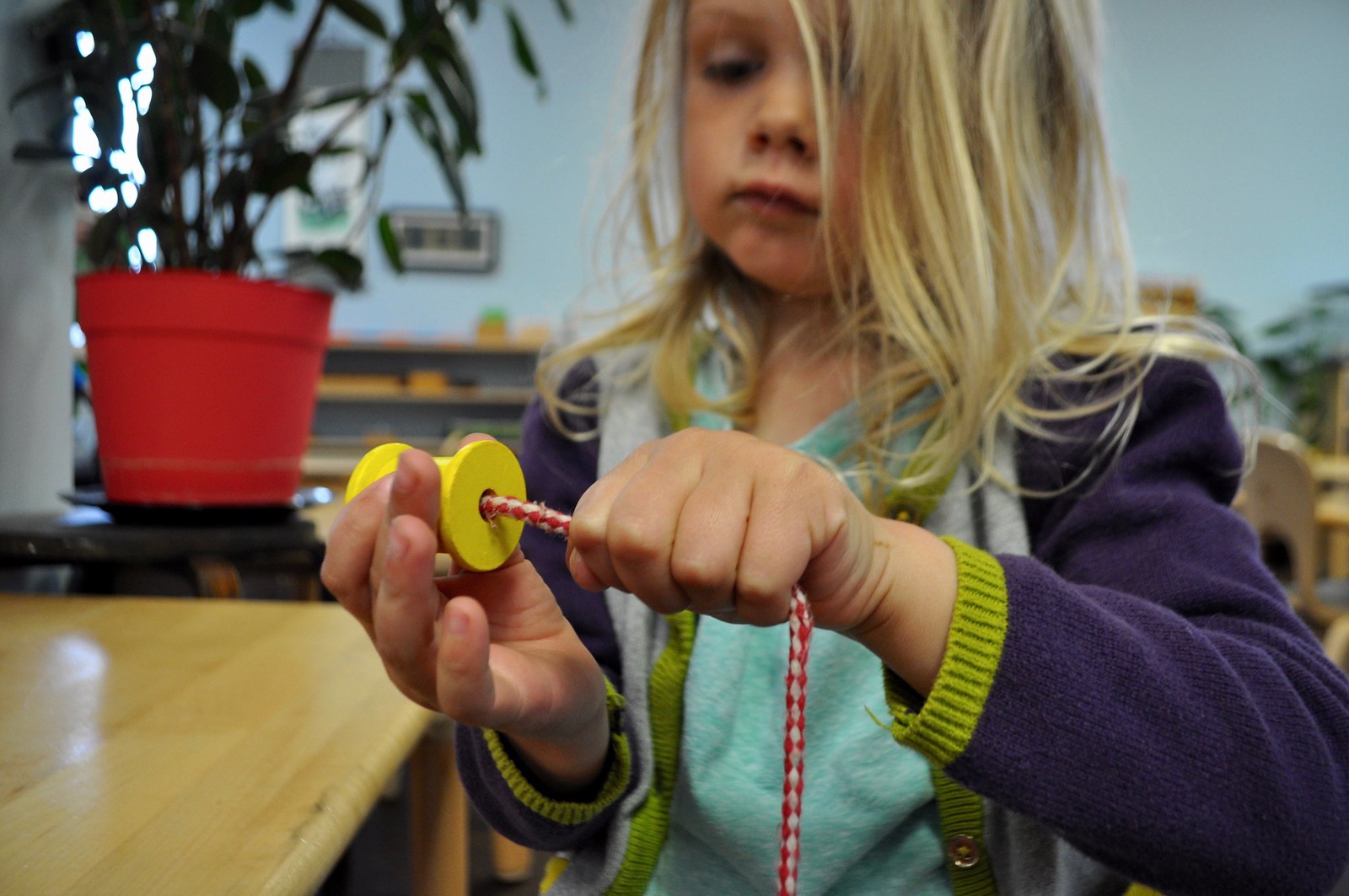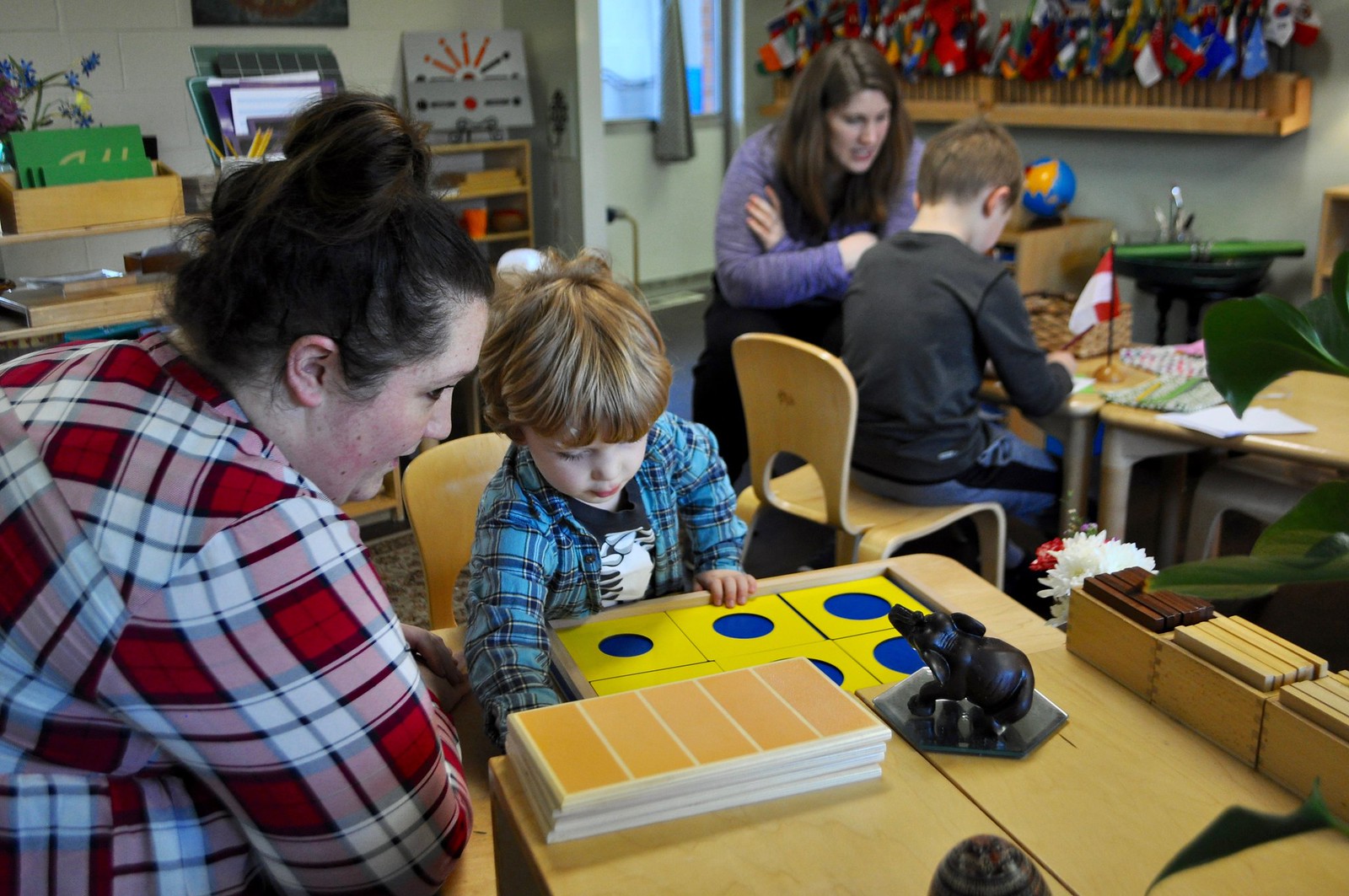 Sharing is a tricky topic; oftentimes we, as parents, place high value on our children's ability to generously share their prized possessions during play dates and outings. But should we force our children to share? An unconventional view, below.
Sharing is a tricky topic; oftentimes we, as parents, place high value on our children's ability to generously share their prized possessions during play dates and outings. But should we force our children to share? An unconventional view, below.  First: the development piece. In order to share genuinely and truly from the heart, a child must be developmentally ready. Oftentimes (and much to the chagrin of parents) this means a toddler or young preschool-aged child is nowhere near being ready to share! This is difficult when we as parents want our children to be kind, generous, and aware of others' needs and desires. But sharing, like any other skill, takes time and practice to develop, and there are times when we should support our child's choice not to share.For the child in the First Plane of Development (in particular the first half of this plane: the 0-3 year age range), sharing is quite difficult. During ages 0-3, a child is in the stage of the unconscious being. An unconscious being is solely engaged in the construction of the self; he is learning who he is in relation to his environment, and thus not yet able to take into consideration other people's thoughts and feelings.
First: the development piece. In order to share genuinely and truly from the heart, a child must be developmentally ready. Oftentimes (and much to the chagrin of parents) this means a toddler or young preschool-aged child is nowhere near being ready to share! This is difficult when we as parents want our children to be kind, generous, and aware of others' needs and desires. But sharing, like any other skill, takes time and practice to develop, and there are times when we should support our child's choice not to share.For the child in the First Plane of Development (in particular the first half of this plane: the 0-3 year age range), sharing is quite difficult. During ages 0-3, a child is in the stage of the unconscious being. An unconscious being is solely engaged in the construction of the self; he is learning who he is in relation to his environment, and thus not yet able to take into consideration other people's thoughts and feelings. Once a child is in the 3-6 age range, he begins to develop the ability to share. However, this is a time for teaching, not forcing. A child who is forced to share and constantly managed by an adult will often develop the idea that he is not in charge of his things, and may begin hoarding them in order to avoid them being taken away. This, obviously, is undesirable behavior.Children develop a strong sense of fairness as they grow older. In effect, being forced to share can be translated to them as others can take what they want from me, but I may not take from them. This, obviously, does not seem fair, and goes against their understanding of the term. Imagine if someone walked up to you today and demanded your car keys, stating that he would like to share your car for a few hours? Then imagine that someone else stepped in after you said "No, sorry, I'd like to use my car today" and took your car keys from your hands, handed them to the other person, turned to you, and said, "We need to share with others, you know." How infuriating would that be?! How unfair is this scenario? It is the same feeling for a child when he is forced to share.
Once a child is in the 3-6 age range, he begins to develop the ability to share. However, this is a time for teaching, not forcing. A child who is forced to share and constantly managed by an adult will often develop the idea that he is not in charge of his things, and may begin hoarding them in order to avoid them being taken away. This, obviously, is undesirable behavior.Children develop a strong sense of fairness as they grow older. In effect, being forced to share can be translated to them as others can take what they want from me, but I may not take from them. This, obviously, does not seem fair, and goes against their understanding of the term. Imagine if someone walked up to you today and demanded your car keys, stating that he would like to share your car for a few hours? Then imagine that someone else stepped in after you said "No, sorry, I'd like to use my car today" and took your car keys from your hands, handed them to the other person, turned to you, and said, "We need to share with others, you know." How infuriating would that be?! How unfair is this scenario? It is the same feeling for a child when he is forced to share. Aside from these reasons, there is another important perspective worth taking. Do we want our children to believe that if they want something that someone else has, they have a right to walk up and take it from them simply because they want it? This is not representative of how the grown up world works, so shouldn't we prepare a child for the reality that there will be plenty of times he will not get what he wants?And yet, of course, we want to encourage our children to share, on their terms, and for the right reasons. Below, some tips on how to encourage your young child to share, without forcing him or her to do so.
Aside from these reasons, there is another important perspective worth taking. Do we want our children to believe that if they want something that someone else has, they have a right to walk up and take it from them simply because they want it? This is not representative of how the grown up world works, so shouldn't we prepare a child for the reality that there will be plenty of times he will not get what he wants?And yet, of course, we want to encourage our children to share, on their terms, and for the right reasons. Below, some tips on how to encourage your young child to share, without forcing him or her to do so. Encourage a mindset of giving.Make giving a priority in your child's life both by demonstrating generosity yourself, and by giving to others in moments when it is unexpected and not asked for. For instance, dropping by the neighbor's house with fresh-baked cookies or drawing a picture ahead of time to share with a playmate are both instances of sharing that do not conflict with your child's idea of fairness. No one is forcing the child to give up something he has in the moment; rather, he is sharing of his own volition, in his own way. Montessori education meets the giving mindset through lessons of Grace and Courtesy.
Encourage a mindset of giving.Make giving a priority in your child's life both by demonstrating generosity yourself, and by giving to others in moments when it is unexpected and not asked for. For instance, dropping by the neighbor's house with fresh-baked cookies or drawing a picture ahead of time to share with a playmate are both instances of sharing that do not conflict with your child's idea of fairness. No one is forcing the child to give up something he has in the moment; rather, he is sharing of his own volition, in his own way. Montessori education meets the giving mindset through lessons of Grace and Courtesy. Use the idea of turn-taking as a way to introduce sharing.*Discuss with your child the importance of taking turns, especially when in neutral territory. We all understand the fairness of letting another child use the monkey bars or waiting your turn in line at the drinking fountain. Use positive reinforcement when your child waits her turn, and when your child offers another child the space and time to use his turn.Choose wisely.Prepare your child in advance for play dates by allowing her to put away in advance anything she would like to remain private, or does not feel like sharing that day. If she would rather not share her brand new prized possession with her friend, that's okay, and you will probably help head off any conflicts around sharing it if you allow her to put it out of reach or sight beforehand. Similarly, if you are headed to the playground, allow your child to think about what toys he may want to bring, and what he may want to leave behind.Discuss, discuss, discuss.Make time to discuss how others may feel when we share with them, and how it feels to be shared with. Associate positive feelings with sharing! In addition to sharing/not sharing, we need to discuss how rotten it feels when someone grabs something we are working with. In this way, we can encourage empathy in our children and naturally discourage grabbiness. It is equally important to teach our children to be assertive when someone grabs something from them. Give children some words to use in these situations: for instance, "Excuse me, I was not finished with that. I'm happy to share it with you once I'm finished using it," may work in some instances.
Use the idea of turn-taking as a way to introduce sharing.*Discuss with your child the importance of taking turns, especially when in neutral territory. We all understand the fairness of letting another child use the monkey bars or waiting your turn in line at the drinking fountain. Use positive reinforcement when your child waits her turn, and when your child offers another child the space and time to use his turn.Choose wisely.Prepare your child in advance for play dates by allowing her to put away in advance anything she would like to remain private, or does not feel like sharing that day. If she would rather not share her brand new prized possession with her friend, that's okay, and you will probably help head off any conflicts around sharing it if you allow her to put it out of reach or sight beforehand. Similarly, if you are headed to the playground, allow your child to think about what toys he may want to bring, and what he may want to leave behind.Discuss, discuss, discuss.Make time to discuss how others may feel when we share with them, and how it feels to be shared with. Associate positive feelings with sharing! In addition to sharing/not sharing, we need to discuss how rotten it feels when someone grabs something we are working with. In this way, we can encourage empathy in our children and naturally discourage grabbiness. It is equally important to teach our children to be assertive when someone grabs something from them. Give children some words to use in these situations: for instance, "Excuse me, I was not finished with that. I'm happy to share it with you once I'm finished using it," may work in some instances. Step in when necessary; gently guide your child while in conflict.If two children are arguing about sharing an item, help them through the conflict, but only step in if the situation is escalating and it is clear that the problem is not going to be resolved without the help of an adult or mediator. Sometimes using "observing words" helps. For instance, saying "I see that both you and John would like a turn with the ball. What should we do?" can empower both children to come up with a solution together. "How about John has a turn for five minutes with the ball, then it will be your turn for five minutes?" Rest assured that while your young child may be hesitant to share at first, as he grows older, becomes socialized, and understands the give and take of friendship and social reciprocity, he will develop the skills necessary for sharing, and it will be much more meaningful and heartfelt if he experiences the freedom to make the choice on his own.*Starting in the Children's House, children as young as two years old are introduced to the idea of turn-taking; Montessori materials must be shared, as there is often only one "set" of something on a shelf. In this way, children learn to wait their turn for a work, and to choose something else in the meantime!
Step in when necessary; gently guide your child while in conflict.If two children are arguing about sharing an item, help them through the conflict, but only step in if the situation is escalating and it is clear that the problem is not going to be resolved without the help of an adult or mediator. Sometimes using "observing words" helps. For instance, saying "I see that both you and John would like a turn with the ball. What should we do?" can empower both children to come up with a solution together. "How about John has a turn for five minutes with the ball, then it will be your turn for five minutes?" Rest assured that while your young child may be hesitant to share at first, as he grows older, becomes socialized, and understands the give and take of friendship and social reciprocity, he will develop the skills necessary for sharing, and it will be much more meaningful and heartfelt if he experiences the freedom to make the choice on his own.*Starting in the Children's House, children as young as two years old are introduced to the idea of turn-taking; Montessori materials must be shared, as there is often only one "set" of something on a shelf. In this way, children learn to wait their turn for a work, and to choose something else in the meantime!
 If you haven’t already come up with your favorite way to answer those questions about what Montessori is and what makes Montessori unique, here’s a great way to answer: observation.
If you haven’t already come up with your favorite way to answer those questions about what Montessori is and what makes Montessori unique, here’s a great way to answer: observation. Dr. Montessori did not impose a method which happened to work. Rather, her pedagogy arose from her continued observation of children. She noticed which materials the children were drawn to and what type of work they wanted to do. The brilliance she gifted us with is a result of her skilled observation.
Dr. Montessori did not impose a method which happened to work. Rather, her pedagogy arose from her continued observation of children. She noticed which materials the children were drawn to and what type of work they wanted to do. The brilliance she gifted us with is a result of her skilled observation.
 Observation remains the foundational piece of implementing Montessori in the classroom. Through observation the guide gets to know the child and determines how best to link them with the environment. Through purposeful and conscientious noticing, the guide is able to offer the right lesson at just the right time. This in turn leads to repetition, concentration, and true learning.
Observation remains the foundational piece of implementing Montessori in the classroom. Through observation the guide gets to know the child and determines how best to link them with the environment. Through purposeful and conscientious noticing, the guide is able to offer the right lesson at just the right time. This in turn leads to repetition, concentration, and true learning. As the school year progresses and the children are settling into their environments, parents are invited to get in on the magic by observing in the classroom. This opportunity is an essential part of parent education and a great avenue toward understanding your child’s classroom experience. Observing is also the best way to prepare yourself for parent-teacher conferences!
As the school year progresses and the children are settling into their environments, parents are invited to get in on the magic by observing in the classroom. This opportunity is an essential part of parent education and a great avenue toward understanding your child’s classroom experience. Observing is also the best way to prepare yourself for parent-teacher conferences! Here are some things to look for and/or keep in mind when you observe:
Here are some things to look for and/or keep in mind when you observe:
 Observation is what allows Montessori to come alive. Please come and join us in the classroom!(Isn't Melinda Smith just amazing with her camera? Thank you Melinda!)
Observation is what allows Montessori to come alive. Please come and join us in the classroom!(Isn't Melinda Smith just amazing with her camera? Thank you Melinda!)

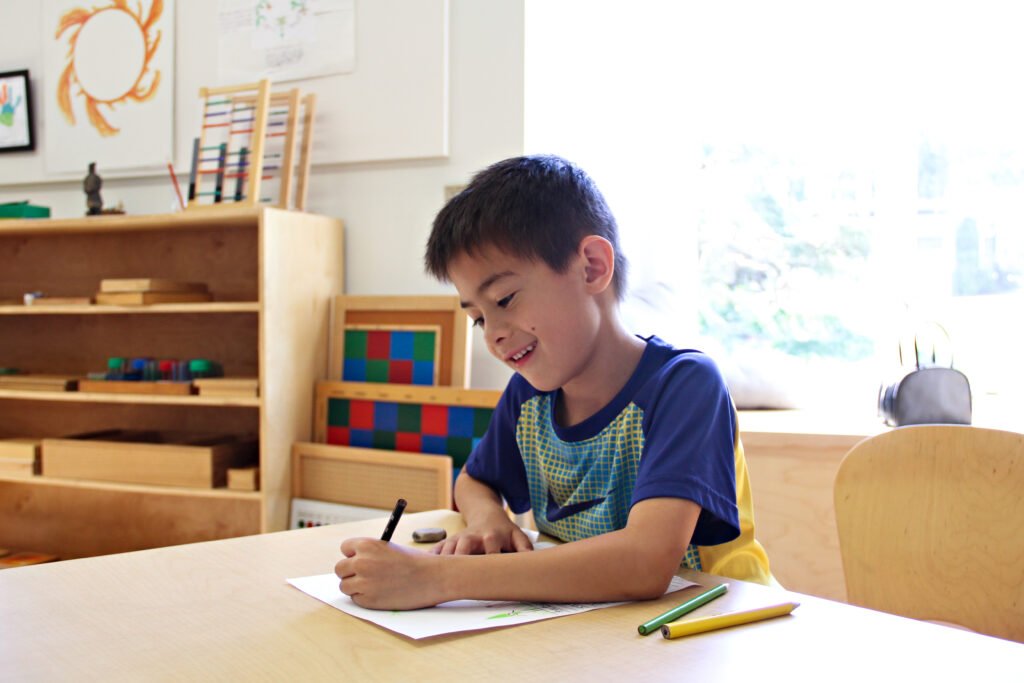 “The first essential for the child's development is concentration. The child who concentrates is immensely happy.”
“The first essential for the child's development is concentration. The child who concentrates is immensely happy.” Montessori environments inherently bolster the development of concentration. The three-hour work period affords extended time without interruption which is vital for concentration to thrive. Further, the materials themselves are attractive to the children, inviting repetition which in turn leads to concentration.
Montessori environments inherently bolster the development of concentration. The three-hour work period affords extended time without interruption which is vital for concentration to thrive. Further, the materials themselves are attractive to the children, inviting repetition which in turn leads to concentration.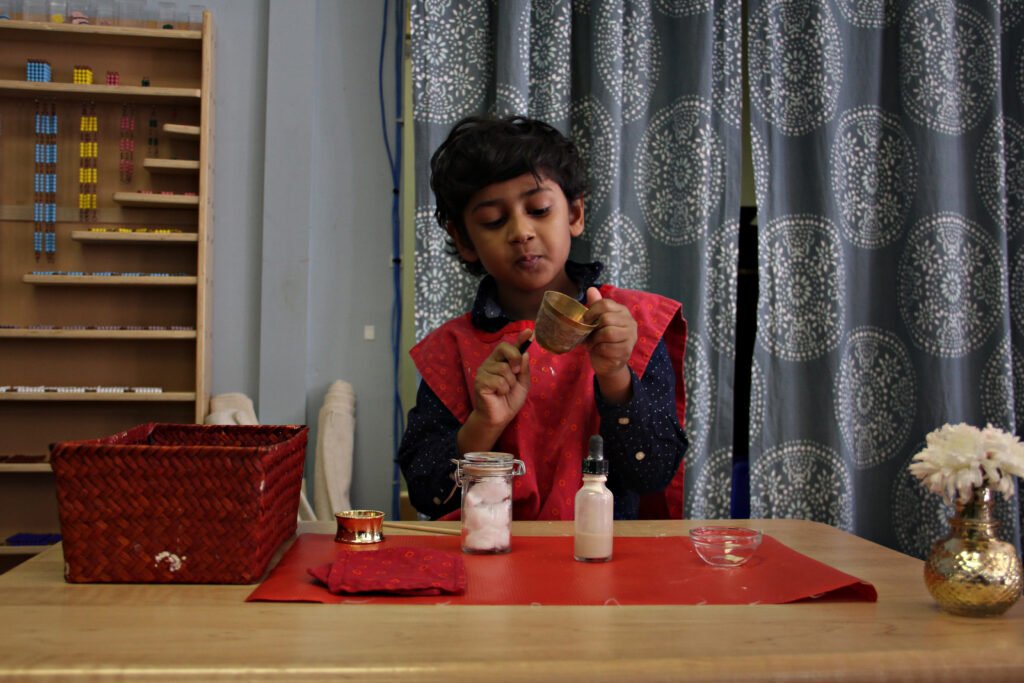
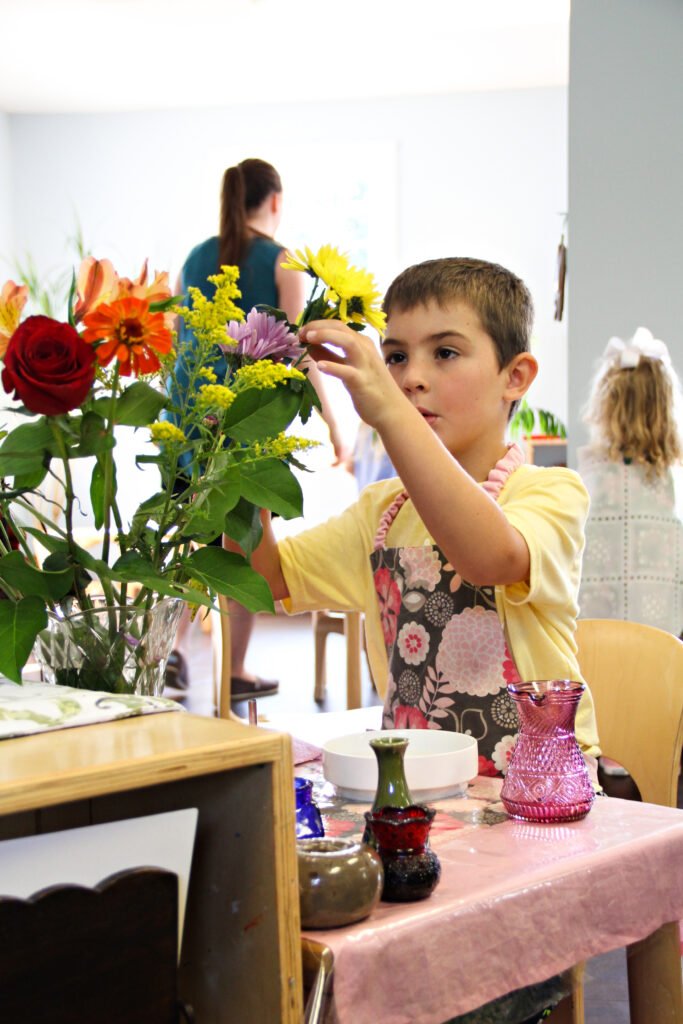 As is true at school, when your child is concentrating on meaningful work at home, please do not interrupt them unless absolutely necessary. Their work may not seem meaningful to adult eyes, but balancing playing cards, tying and untying bows, lining up all the shoes in the house... This is all meaningful work.
As is true at school, when your child is concentrating on meaningful work at home, please do not interrupt them unless absolutely necessary. Their work may not seem meaningful to adult eyes, but balancing playing cards, tying and untying bows, lining up all the shoes in the house... This is all meaningful work.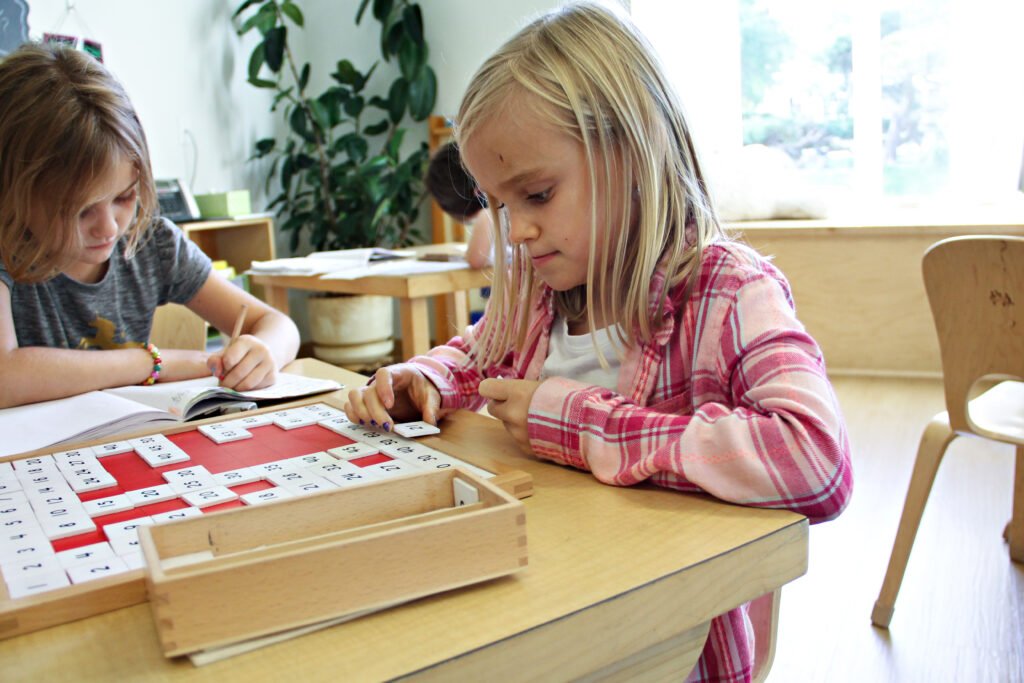 The sight of a child concentrating can transport us. We sense the feeling of deep calm and focus we too experience when we are allowed to fully lose ourselves to a productive task. Concentration is a beautiful thing to witness. Here we are witnesses to the moment of learning, the acquisition of knowledge.
The sight of a child concentrating can transport us. We sense the feeling of deep calm and focus we too experience when we are allowed to fully lose ourselves to a productive task. Concentration is a beautiful thing to witness. Here we are witnesses to the moment of learning, the acquisition of knowledge.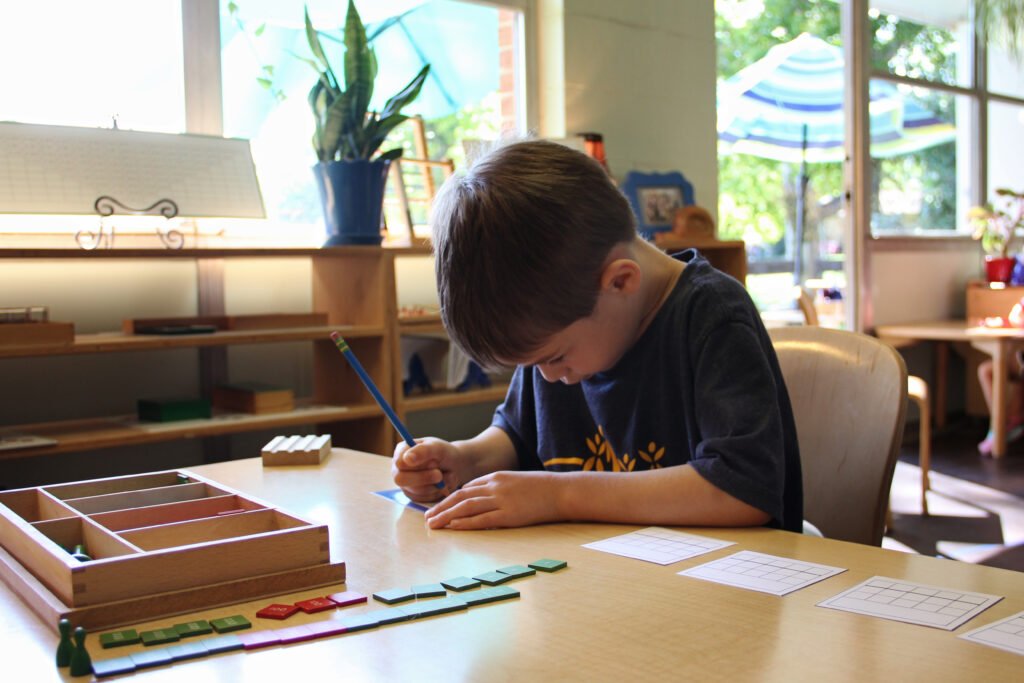 Many thanks to Melinda Smith for sharing her splendid photography.
Many thanks to Melinda Smith for sharing her splendid photography.
 Describe your educational background.I have a Bachelor of Fine Arts in Studio Art with a specialization in metalsmithing, a Bachelor of Science in Art Education and a Master of Fine Arts in metalsmithing.How/when did you become interested in Montessori education?I worked as a part time assistant at Raintree Montessori School in Lawrence, KS for a year and a half. I had no idea how Montessori worked before this.What has been the BEST part of your Montessori experience so far?I just love seeing the children do things on their own that society at large does not think children are capable of doing at that age. It's wonderful and magical to see.
Describe your educational background.I have a Bachelor of Fine Arts in Studio Art with a specialization in metalsmithing, a Bachelor of Science in Art Education and a Master of Fine Arts in metalsmithing.How/when did you become interested in Montessori education?I worked as a part time assistant at Raintree Montessori School in Lawrence, KS for a year and a half. I had no idea how Montessori worked before this.What has been the BEST part of your Montessori experience so far?I just love seeing the children do things on their own that society at large does not think children are capable of doing at that age. It's wonderful and magical to see. What do you enjoy doing outside of your time at VdM?I enjoy hanging out with my dog, walking, running, hiking, etc. I also spend a lot of time making art, mostly via sewing lately.If you were to plan a most perfect, relaxing weekend day, what would it entail?I would go camping and hiking with my close friends and my dog.What is something you look forward to this coming school year?I look forward to getting to know all the children and staff and feeling like part of the family at Villa di Maria.
What do you enjoy doing outside of your time at VdM?I enjoy hanging out with my dog, walking, running, hiking, etc. I also spend a lot of time making art, mostly via sewing lately.If you were to plan a most perfect, relaxing weekend day, what would it entail?I would go camping and hiking with my close friends and my dog.What is something you look forward to this coming school year?I look forward to getting to know all the children and staff and feeling like part of the family at Villa di Maria. Your Favorite:Color: GreenSeason: SpringBook: Jane EyreHoliday: NoneHobby: ReadingType of music: Indie, folkSong: Too many, no way I can chooseVacation: BeachSport: YogaGame: ClueFruit: MangoVegetable: Garlic?
Your Favorite:Color: GreenSeason: SpringBook: Jane EyreHoliday: NoneHobby: ReadingType of music: Indie, folkSong: Too many, no way I can chooseVacation: BeachSport: YogaGame: ClueFruit: MangoVegetable: Garlic?

 Describe your educational background.I have an Associate’s degree in Human Services (working with children). I then promptly ran off to Europe and moved to Corsica where I was an organic farmer in the mountains with no electricity, phone, or running water (at first) for almost 11 years. I built a campground with a small pavilion restaurant and did this for a few years, but alas I was called back to the States to be with my Father who was diagnosed with cancer. I moved back home to Kirkwood just 4 blocks from Villa where I grew up. My son wanted to stay with his American family, so after my Dad passed, I went back to school and received a Bachelor’s degree in French Literature from UMSL with a K-12 teaching certificate. I taught French at Kirkwood and Webster Groves high school for 2 years.How/when did you become interested in Montessori education?I got married and moved to Chesterfield, Mo and had my second son. When he was three, I started looking for a school, and found one just down the street. Fell in love with the school and Montessori education. After a year and half, I had an opportunity to teach French there part-time which then morphed into full-time shortly after. I worked there for almost 15 years. I went from teaching French in the afternoon to substituting in the mornings, almost 8 years as a primary assistant and finally toddler assistant this past year, while still teaching French to the elementary and Adolescent students in the afternoon. My son graduated from there in 8th grade went on to SLUH and is now a freshman at Loyola University of Chicago. He received an amazing education and is a wonderful human being, which I accredit to this wonderful education.
Describe your educational background.I have an Associate’s degree in Human Services (working with children). I then promptly ran off to Europe and moved to Corsica where I was an organic farmer in the mountains with no electricity, phone, or running water (at first) for almost 11 years. I built a campground with a small pavilion restaurant and did this for a few years, but alas I was called back to the States to be with my Father who was diagnosed with cancer. I moved back home to Kirkwood just 4 blocks from Villa where I grew up. My son wanted to stay with his American family, so after my Dad passed, I went back to school and received a Bachelor’s degree in French Literature from UMSL with a K-12 teaching certificate. I taught French at Kirkwood and Webster Groves high school for 2 years.How/when did you become interested in Montessori education?I got married and moved to Chesterfield, Mo and had my second son. When he was three, I started looking for a school, and found one just down the street. Fell in love with the school and Montessori education. After a year and half, I had an opportunity to teach French there part-time which then morphed into full-time shortly after. I worked there for almost 15 years. I went from teaching French in the afternoon to substituting in the mornings, almost 8 years as a primary assistant and finally toddler assistant this past year, while still teaching French to the elementary and Adolescent students in the afternoon. My son graduated from there in 8th grade went on to SLUH and is now a freshman at Loyola University of Chicago. He received an amazing education and is a wonderful human being, which I accredit to this wonderful education. What has been the BEST part of your Montessori training/experience so far?I think the best experiences is watching the primary students grow and move into elementary and witness the amazing changes. Some of these children struggled in their early years, but eventually they discovered their potential, and this gives me comfort, faith and knowledge that this education can transform our children into confident young people who embrace the world of learning.What do you enjoy doing outside of your time at VdM?Being with my grandson, who will be one this month.If you were to plan a most perfect, relaxing weekend day, what would it entail?It would be a day in the mountains in a log cabin completely isolated from the world.What is something you look forward to this coming school year?I look forward to working with Heather and being back in the primary classroom.
What has been the BEST part of your Montessori training/experience so far?I think the best experiences is watching the primary students grow and move into elementary and witness the amazing changes. Some of these children struggled in their early years, but eventually they discovered their potential, and this gives me comfort, faith and knowledge that this education can transform our children into confident young people who embrace the world of learning.What do you enjoy doing outside of your time at VdM?Being with my grandson, who will be one this month.If you were to plan a most perfect, relaxing weekend day, what would it entail?It would be a day in the mountains in a log cabin completely isolated from the world.What is something you look forward to this coming school year?I look forward to working with Heather and being back in the primary classroom. Favorites:Color: PurpleSeason: FallBook: Lord of the RingsHoliday: ChristmasMovie: WillowHobby: CookingType of music: Soft RockSong: "Here I am Lord"Restaurant in St. Louis: Ya Ya'sVacation: France/EuropeSport: Horseback ridingGame: French TarotFruit: AppleVegetable: All except okraIf you had to choose ONE:Rain or Snow: RainCoffee or Tea: TeaMorning or Night: MorningOcean or Lake: LakeDog or Cat: CatTalk or Listen: BothWalk or Run: WalkSave or Spend: SpendBike or Swim: BikeSalt or Pepper: SaltRealistic Fiction or Fantasy: FantasySummer or Winter: Summer in the mountainsNew York or California: CaliforniaCook or Dine Out: Cook
Favorites:Color: PurpleSeason: FallBook: Lord of the RingsHoliday: ChristmasMovie: WillowHobby: CookingType of music: Soft RockSong: "Here I am Lord"Restaurant in St. Louis: Ya Ya'sVacation: France/EuropeSport: Horseback ridingGame: French TarotFruit: AppleVegetable: All except okraIf you had to choose ONE:Rain or Snow: RainCoffee or Tea: TeaMorning or Night: MorningOcean or Lake: LakeDog or Cat: CatTalk or Listen: BothWalk or Run: WalkSave or Spend: SpendBike or Swim: BikeSalt or Pepper: SaltRealistic Fiction or Fantasy: FantasySummer or Winter: Summer in the mountainsNew York or California: CaliforniaCook or Dine Out: Cook

 Like most things in the Montessori classroom, lunch is a multi-faceted opportunity for growth. It provides occasions for choice making, self-sufficiency and increasing hand strength and dexterity. It’s a time to practice social graces, build community and learn table manners. Our work at home regarding lunch preparation can feed this work in the classroom, allowing the children to get the most out of mealtime at school.
Like most things in the Montessori classroom, lunch is a multi-faceted opportunity for growth. It provides occasions for choice making, self-sufficiency and increasing hand strength and dexterity. It’s a time to practice social graces, build community and learn table manners. Our work at home regarding lunch preparation can feed this work in the classroom, allowing the children to get the most out of mealtime at school.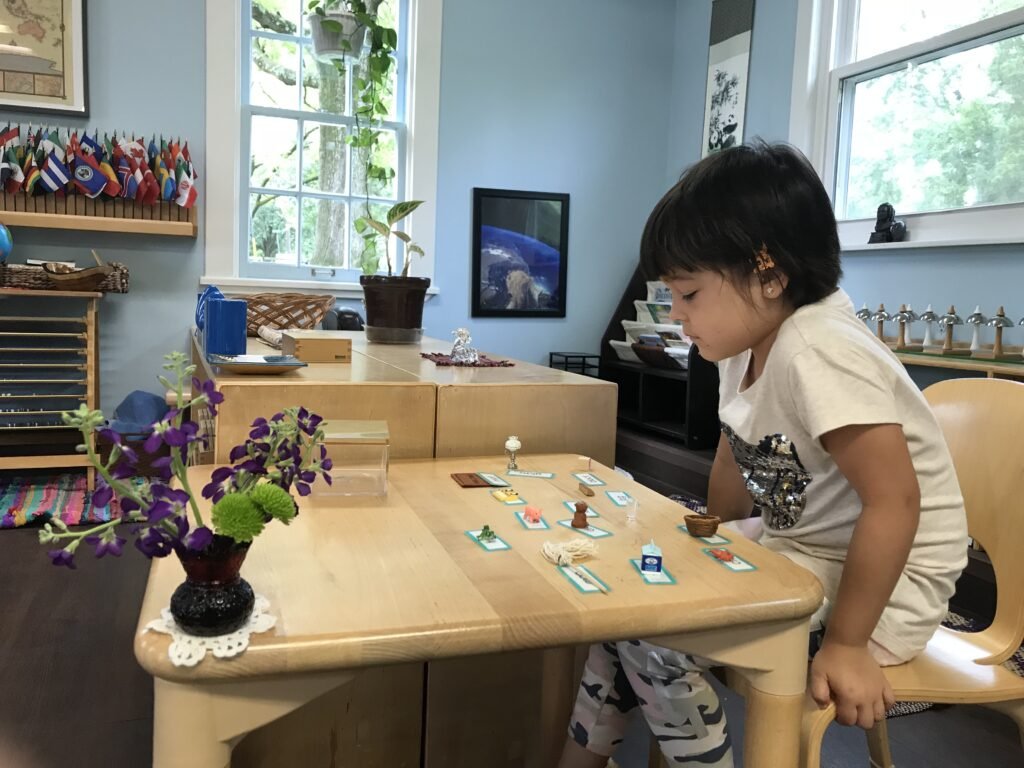 When thinking about lunches, we must keep in mind how much our children work while they are at school. The youngest are building their personalities, refining their movement, expanding their language and working with numbers. Elementary children are figuring out their social selves and actively pursuing new learning.After a three-hour work period, children need to replenish their energy with a healthy lunch. Extended day and elementary children need their lunch to provide the nourishment for their afternoon work.While we've all had the occasional day where we pretend that the cheese flavoring in the bag of Doritos counts as protein and fruit snacks are actually fruit, we also know this has to be the exception rather than the rule in order for our children to have what they need at to thrive at school.In the Children’s House a protein, fruit and vegetable will suffice for most children. Elementary children will likely need larger portions; figuring out how much they need is a conversation you can have with your child at the end of the day. (Strategies and tips about the actual packing of lunches coming soon!)While adjusting the choices available for lunch, school can be an excuse to deflect pushback. “This is what <insert name of teacher> said…” goes a long way. Use it sparingly and use it wisely, but if you need extra support packing a lunch full of healthy options, this might be one of those moments.
When thinking about lunches, we must keep in mind how much our children work while they are at school. The youngest are building their personalities, refining their movement, expanding their language and working with numbers. Elementary children are figuring out their social selves and actively pursuing new learning.After a three-hour work period, children need to replenish their energy with a healthy lunch. Extended day and elementary children need their lunch to provide the nourishment for their afternoon work.While we've all had the occasional day where we pretend that the cheese flavoring in the bag of Doritos counts as protein and fruit snacks are actually fruit, we also know this has to be the exception rather than the rule in order for our children to have what they need at to thrive at school.In the Children’s House a protein, fruit and vegetable will suffice for most children. Elementary children will likely need larger portions; figuring out how much they need is a conversation you can have with your child at the end of the day. (Strategies and tips about the actual packing of lunches coming soon!)While adjusting the choices available for lunch, school can be an excuse to deflect pushback. “This is what <insert name of teacher> said…” goes a long way. Use it sparingly and use it wisely, but if you need extra support packing a lunch full of healthy options, this might be one of those moments.
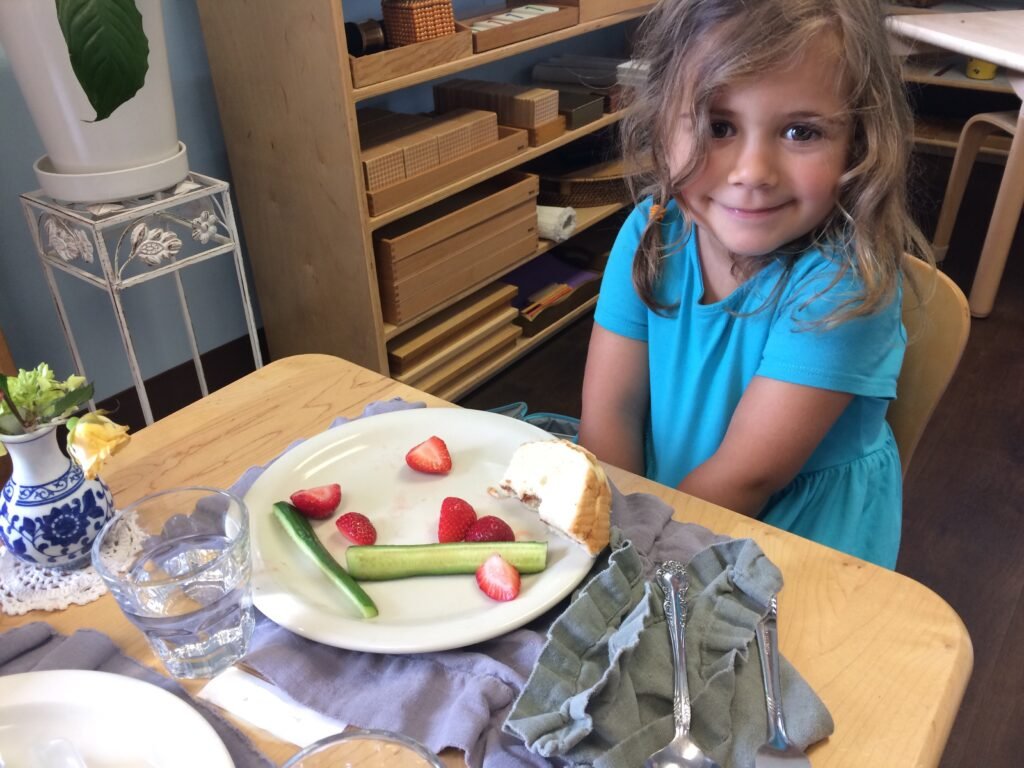 Photo credit: Jessie Braud
Photo credit: Jessie Braud

 We are so excited that 2018-2019 is officially underway!
We are so excited that 2018-2019 is officially underway! Five minutes into the school year and the outdoor environment was in full swing! What better place to do watercolor painting than out in the sunshine.
Five minutes into the school year and the outdoor environment was in full swing! What better place to do watercolor painting than out in the sunshine. The children wasted no time connecting with nature and caring for their environment.
The children wasted no time connecting with nature and caring for their environment. Welcome back fort builders!
Welcome back fort builders! From the very beginning, we end our day with jobs. Taking out the trash and recycling gives the children the opportunity to contribute to the whole community.Here's to a fabulous year!
From the very beginning, we end our day with jobs. Taking out the trash and recycling gives the children the opportunity to contribute to the whole community.Here's to a fabulous year!
 The prepared environment is central to Montessori theory and crucial to its practice. Each environment is specially designed to meet the needs of the children who occupy it. Our guides, assistants and staff have been working tirelessly to prepare each of our environments for the children. And we cannot wait for them to come!
The prepared environment is central to Montessori theory and crucial to its practice. Each environment is specially designed to meet the needs of the children who occupy it. Our guides, assistants and staff have been working tirelessly to prepare each of our environments for the children. And we cannot wait for them to come! In preparing the environments, guides have taken into consideration everything from the sequence of the materials to the natural light in the room. They have contemplated daily routines, how the children will move through the room, and placement of artwork. Each decision was made while holding central the needs of the children.
In preparing the environments, guides have taken into consideration everything from the sequence of the materials to the natural light in the room. They have contemplated daily routines, how the children will move through the room, and placement of artwork. Each decision was made while holding central the needs of the children. It is not just the physical space which has been prepared. The guides, assistants and staff have also been preparing themselves through the summer and over the past few weeks in particular.
It is not just the physical space which has been prepared. The guides, assistants and staff have also been preparing themselves through the summer and over the past few weeks in particular. Preparation of the adult is an ongoing process. It requires self-reflection and conscious work so that we offer the best of ourselves to the children. Self-preparation takes many different routes. Some read books, some catch up on much needed self-care, some attend lectures or workshops. As a whole, the staff has engaged in anti-bias, anti-racist training. All of this work is to bring our best selves to your children.
Preparation of the adult is an ongoing process. It requires self-reflection and conscious work so that we offer the best of ourselves to the children. Self-preparation takes many different routes. Some read books, some catch up on much needed self-care, some attend lectures or workshops. As a whole, the staff has engaged in anti-bias, anti-racist training. All of this work is to bring our best selves to your children. Our guides do not model perfection but rather curiosity, kindness, and a friendliness toward error which results in true learning and resiliency. Guides model human beings who choose to walk on the path toward reaching their potential. This is the very path on which we invite the children to join us. It’s the path we lay for them by preparing the environment.
Our guides do not model perfection but rather curiosity, kindness, and a friendliness toward error which results in true learning and resiliency. Guides model human beings who choose to walk on the path toward reaching their potential. This is the very path on which we invite the children to join us. It’s the path we lay for them by preparing the environment. Welcome and welcome back!All photography is thanks to Melinda Smith.
Welcome and welcome back!All photography is thanks to Melinda Smith.










































































